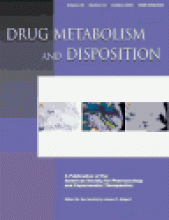Abstract
N-Glucuronidation at an aromatic tertiary amine of 5-membered polyaza ring systems was investigated for a model series of eight 1-substituted imidazoles in liver microsomes from five species. The major objectives were to investigate substrate specificities of the series in human microsomes and interspecies variation for the prototype molecule, 1-phenylimidazole. The formed quaternary ammonium-linked metabolites were characterized by positive ion electrospray mass spectrometry. The incubation conditions for theN-glucuronidation of 1-substituted imidazoles were optimized; where for membrane disrupting agents, alamethicin was more effective than the detergents examined. The need to optimize alamethicin concentration was indicated by 4-fold interspecies variation in optimal concentration and by a change in effect from removal of glucuronidation latency to inhibition on increasing concentration. For the four species with quantifiableN-glucuronidation of 1-phenylimidazole, there were 8- and 18-fold variations in the determined apparentKm (range, 0.63 to 4.8 mM) andVmax (range, 0.08 to 1.4 nmol/min/mg of protein) values, respectively. The apparent clearance values (Vmax/Km) were in the following order: human ≅ guinea pig ≅ rabbit > rat ≅ dog (no metabolite detected). Monophasic kinetics were observed for theN-glucuronidation of seven substrates by human liver microsomes, which suggests that one enzyme is involved in each metabolic catalysis. No N-glucuronidation was observed for the substrate containing the para-phenyl substituent with the largest electron withdrawing effect, 1-(4-nitrophenyl)imidazole. Linear correlation analyses between apparent microsomal kinetics and substrate physicochemical parameters revealed significant correlations between Kmand lipophilicity (πpara or log P values) and betweenVmax/Km and both electronic properties (ςpara value) and pKa.
Footnotes
-
↵1 Current address: Wyeth Research, 500 Arcola Road, Collegeville, PA 19426-3930.
-
↵2 Current address: Lilly Research Laboratories, Lilly Corporate Center, Indianapolis, IN 46285.
-
This work was supported by an AstraZeneca academic grant (to E.M.H. and D.J.M.), a Canadian Institutes of Health Research operating grant (MOP-36513 to E.M.H.), and a Health Services Utilization and Research Commission of Saskatchewan Research Fellowship (to O.G.).
- Abbreviations used are::
- UGT
- UDP-glucuronosyltransferase
- N+-glucuronide
- quaternary ammonium-linked glucuronide metabolite
- SMR
- structure-metabolism relationships
- CHAPS
- 3-[(3-cholamidopropyl)dimethylamino]-1-propanesulfonate
- UDPGA
- UDP-glucuronic acid
- HPLC
- high-performance liquid chromatography
- ESI
- electrospray ionization
- MS
- mass spectrometry
- APCI
- atmospheric pressure chemical ionization
- Received February 15, 2002.
- Accepted June 19, 2002.
- The American Society for Pharmacology and Experimental Therapeutics
DMD articles become freely available 12 months after publication, and remain freely available for 5 years.Non-open access articles that fall outside this five year window are available only to institutional subscribers and current ASPET members, or through the article purchase feature at the bottom of the page.
|






